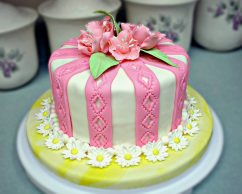In-Depths Yesterday, we shared our in-depth articles. We heard three articles, of varying lengths, that used the required elements of an in-depth; research and attribution (quotes or paraphrasing). It's not too late to submit an in-depth. In fact, I want to stress that the assignment was not optional. Everyone should be giving as much effort as possible on all assignments. This is the right venue to try and even fail! There are no grades and we are all here to support one another...and learn! Students can change their topic if they like. Next week, we will have our layout session for Issue II! I am very excited about this issue as we will be increasing our publication by four pages and including broader and very relevant topics such as beach erosion, working conditions in factories, and the presence of corn and corn by-products in our food supply. Our in-depth article that secured the students' votes to be included in Issue II was an article on the role of cakes in cultural celebrations. Bravo! Deadline Looms The publication date for Issue II is December 17. On Monday, December 10, your student will receive their article back from the News Editor. We are going to be experiencing the true meaning of deadline with this issue. Your student must email to me by MIDNIGHT December 11, his or her edited article, or it will not be included in this issue. Since we would have secured a spot for the student's article in the layout session, this means that failure to meet the deadline will result in major content problems for the paper (and the Editor-in-Chief, i.e., Yours Truly), therefore, missing the deadline is not optional. Fairy Tales To lighten the mood a little yesterday, we used the Grimm Brothers' version of "The Three Little Pigs" to illustrate the concept of "the missing voice" in a story, commonly known as perspective. To investigate "the other side of the story" we read through (in readers theater style) "The True Story of the Three Little Pigs" by Jon Scieszka, where we learn the "Big Bad Wolf" was mistakenly labeled through a simple misunderstanding. :>) For homework, students were given the mission of re-writing a fairy tale from the perspective of a minor character that appears in the story. I gave them several options, and we went around the room and each student committed to a tale and a character. They are allowed to choose a different story and character if it stays true to the purpose of the exercise, but everyone should present a fairy tale on Monday. The choices were; Rapunzel, Cinderella, Hansel and Gretel, Rumpelstiltskin, and The Wizard of Oz. Next week in addition to the layout session, we will be exploring bias in media and how it differs from perspective. See you then!  Our discussion of Ben and Me began this week with a short geography lesson and mapping exercise, as students worked on identifying the states in the northeastern US on an unlabeled map, and finding Benjamin Franklin's birthplace (Boston) and the setting for the story (Philadelphia), where Franklin spent much of his life. This was a challenging exercise for most of the students! I have provided the blank map (HERE) and would encourage students to repeat this exercise at home to become more familiar with our regional geography. Students then discussed two of Ben's famous maxims from the first chapters of the book ("Waste not, want not" and "The laborer is worthy of his hire"), and gave their personal interpretations of the meanings of these sayings, with examples of how they apply in everyday life. We will continue to discuss the meaning and application of Ben's maxims as we encounter them throughout the book. We then began our dictionary of vocabulary words together and I provided the class with three words from Chapters 1-4. Students should find two new vocabulary words (of their own choosing) from the assigned chapters each week and add them to their dictionary page. I have asked them to list: the word, the sentence from the book where the word is used (for context clues), their initial guess at the word meaning, and then the dictionary definition. The process of stopping to examine the context for word meaning, and then confirming with a dictionary is a great habit to reinforce for vocabulary development. We concluded our class with a hands-on invention activity, having just read Chapter 2, where Ben and Amos together design and build the first Franklin Stove. Students were divided into two teams, given identical sets of everyday supplies (straw, dixie cup, paperclips, rubber bands, mini marshmallows, etc) and then allowed 15 minutes to invent anything they could think of! Teams were not allowed to see what the opposing team was building. Each team was then asked to carefully examine the opposing team's invention, and relay their assessment "telephone-style", with only one team member actually viewing the invention, then explaining to the next team member what they observed, and so on. The last team member provided the class with the final explanation (and drawing) of how the invention was constructed. Both teams ended with good overall explanations of the opposing teams invention, but also missed important aspects and details. A very good exercise for illustrating the importance of effective listening and communicating! Assigned reading for next week: Chapters 5-10. |
Categories
All
Archives
May 2016
|

 RSS Feed
RSS Feed